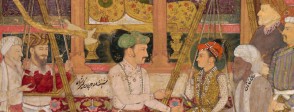The many details of this painting make it good to look at in sections. Divide the class into groups and, using the PDF in For the classroom, give different groups different sections of the painting. Ask them to make very detailed observations of what they can see and to decide what they think is going on in their section. Ask students to feed back to the class, building up ideas as the class pieces together the image.
Looking together at the whole painting, ask students to identify symbols of wealth and status. Explain to the class what the illustration shows. Ask why students think Jahangir wanted to have this event recorded in an image as well as in writing? What information does the image give us that would be harder to communicate in writing? The illustration was created by the emperor’s artists for the emperor. What is the emperor communicating about himself? How? Why should we cautious in using the painting as a source?
Ask students to write a paragraph describing Jahangir as a leader based only on the information communicated in the painting. Ask students to use the museum search links in For the classroom to find more sources about Jahangir such as coins he issued, objects that he owned, further portraits of him and contemporary descriptions. Entering a simple search term such as ‘Jahangir’ should produce plenty of examples. Ask them to write a second paragraph describing Jahangir based on these sources. Do they find any differences?
Compare depictions of Jahangir with portraits of contemporary leaders such as James I, Shāh ‘Abbās of Persia, Henry IV and Louis XIII of France, Philip III of Spain. the Wanli Emperor of Ming China or the Ottoman sultan Ahmed I. Consider the leader’s physical image including clothes and accessories, the activities they are shown doing and the artistic techniques and materials used. Consider who the audience was for each image and differences among representations of the same monarch and representations of different ones.
Another rich topic is the international dimension of the Mughal empire in terms of import and export and influences in art and taste. Using the enlarged section of the painting, identify the Chinese porcelain vessels and figures on shelves in the background of the picture. Compare with the examples in A bigger picture. Find out more about the goods and commodities traded between China and the Mughal empire. Compare how these trade goods were transported and use maps to compare with how European trade operated. Use the mini-lesson in For the classroom to demonstrate the influences on Mughal painting. Look at relevant images and objects in A bigger picture. Ask students to create a digital presentation choosing just one object or image to exemplify the contact between different cultures and how they influenced each other.
Who was the greatest Mughal emperor: Akbar, Jahangir, Shah Jahan or Aurangzeb?
Invite groups of students to curate an exhibition or create a presentation to communicate their conclusions about this enquiry. They should use a range of resources to consider the four candidates looking at how their priorities may have differed and how well they achieved what they set out to achieve. Some of the activities above can be used as openers about Jahangir. Students could also compare the painting of the weighing ceremony with an illustration from his father Akbar’s memoir, depicting his victories in war – see For the classroom. Give students a limit on the number of objects or written sources they can include in their exhibition or presentation so that they have to be selective and make judgements about evidence to support their conclusions. Compare their decisions and how each group supports its argument.
Why did India become part of the British empire?
This enquiry takes in the process of how the East India Company’s activities became established in India, how they developed during the later AD 1600s and the 1700s, how the Company filled the vacuum left by the disintegration of Mughal rule and subsequently increased its power, how it progressively came under scrutiny from the British government, the impact of the Indian Mutiny and the Government of India Act of 1858. However, it also requires students to make evidence-based judgements about why it was the British and not the Dutch or Portuguese who became the dominant European power in India. The activity could be framed as storyboarding or scripting a film. There are useful links, including video clips, in For the classroom and the students could use online museum catalogues to search for objects and images to include in their films.


